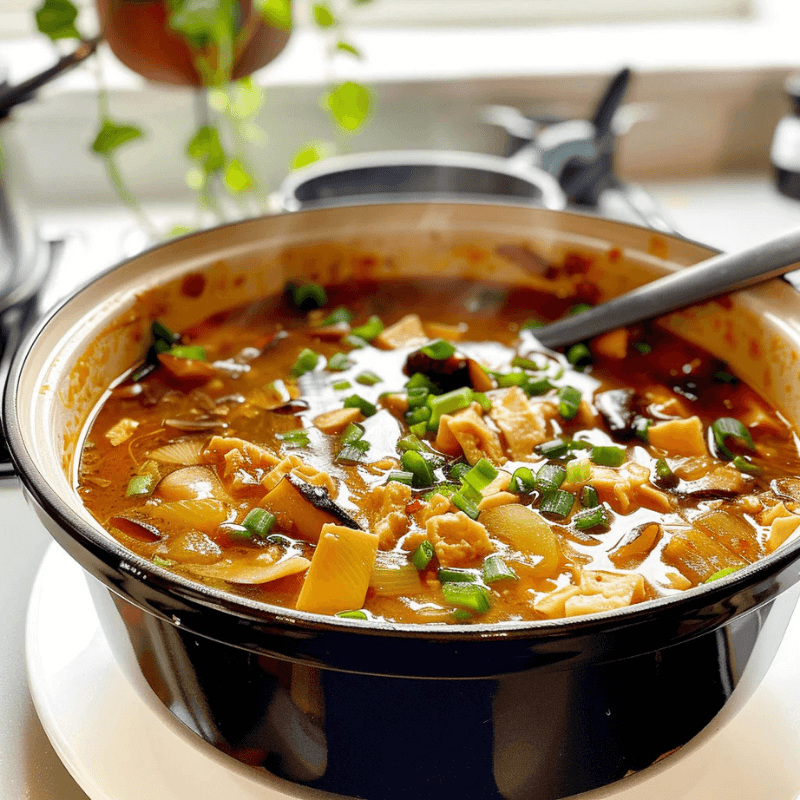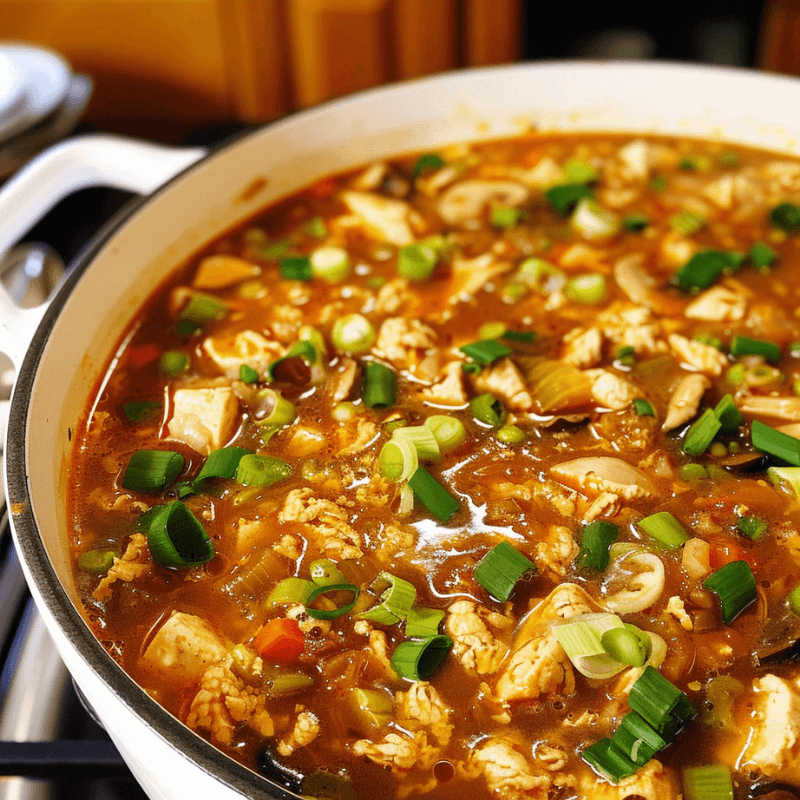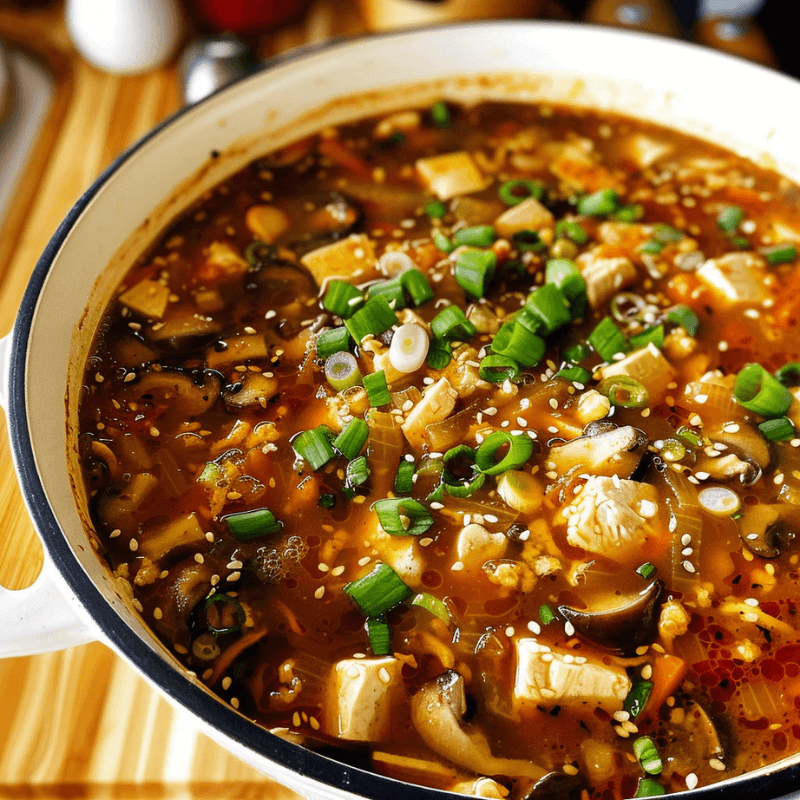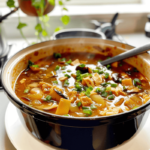Authentic Hot and Sour Soup ranks among the most ordered dishes in Chinese restaurants worldwide, while its quality can vary dramatically from awesomely delicious to disappointingly bland. As someone whose family has deep roots in the restaurant business, I’m excited to share our authentic hot and sour soup recipe that has been perfected over generations.
Despite its complex blend of eight essential ingredients – including three proteins, three dried components, and two vegetables – this soup can be prepared in under 20 minutes. In fact, what makes our family’s recipe special is the precise balance of black rice vinegar, ground white pepper, and unique additions like dried mandarin peel and lily flower that create that perfect hot and sour harmony.
Through this guide, I’ll reveal our time-tested techniques for creating restaurant-quality hot and sour soup at home, complete with the secrets to achieving the ideal texture and flavor that have made this recipe a cherished part of our family’s legacy.
The Story Behind Our Family’s Hot and Sour Soup
My journey with authentic hot and sour soup begins with childhood memories that feel like yesterday. Growing up around my parents’ Chinese restaurant, my sister and I would often sneak into the kitchen to grab pots of my father’s hot and sour soup – it was our favorite treat during busy service hours.

From humble beginnings to restaurant fame
My father, like many Chinese immigrant chefs, arrived in America with culinary skills honed from years of cooking in China. He was just 23 when he left his homeland, bringing with him recipes and techniques passed down through generations. For over 15 years, our family operated a modest restaurant, where both my parents worked tirelessly as the primary cooks.
Our restaurant, Wah Yuen, located in Concord, California, became known for its authentic dishes, particularly my father’s authentic hot and sour soup recipe. Unfortunately, when I was about six years old, our restaurant was lost in a devastating fire. This tragedy prompted my parents to make a difficult decision – my father continued working as a chef in other Chinese restaurants, but my mother returned to her nursing career, which she had abandoned when immigrating to America in 1982.
The pandemic marked a turning point for our family. Realizing how precious our time together was, we started a YouTube channel and blog called “Made with Lau” to document and share our family recipes with the world. Each week, we publish videos where we cook one of my father’s recipes, then sit down together to enjoy the dish and reminisce about our family history.
My father has been cooking Chinese food for over 50 years – from his teenage years in Guangzhou to being the head chef of his own restaurant, and now as the heart of our family kitchen. Now that he’s retired, I’ve made it my mission to capture and share the hundreds of recipes stored only in his memory.
Why this recipe remained a closely guarded secret
Traditional Chinese recipes like our authentic hot and sour soup were typically kept within families for several significant reasons:
- Cultural preservation – Our recipes represent more than just food; they embody our heritage and identity as Chinese Americans. They connect us to our ancestors and origins.
- Instinctual cooking methods – My father, like many older Asian chefs, cooks with instinct rather than precise measurements. This approach showcases personal kitchen skills but makes it extremely challenging to pass down recipes to the next generation.
- Commercial advantage – For family-run restaurants, unique recipes were literally the bread and butter of their livelihood. Keeping certain techniques and ingredient combinations secret provided a competitive edge.
Moreover, hot and sour soup carries historical significance beyond just being a delicious dish. According to food historians, it originated in the western regions of China, likely Sichuan, and exemplifies the art of harmonizing strong, zesty flavors characteristic of that region.
The soup also has healing properties in traditional Chinese medicine – the black wood ear fungus is believed to boost circulation, vinegar aids digestion, and the chicken broth provides warming effects. There’s even a story about how hot and sour soup cured a Ming Dynasty official named Yu Qian from a severe cold.
Each time we make this soup, we’re not just preparing a meal – we’re continuing a tradition that stretches back centuries. By sharing our authentic hot and sour soup recipe today, I’m ensuring that this culinary heritage won’t disappear with my father’s generation but will continue to bring comfort and nourishment to families everywhere.
Essential Ingredients That Make This Soup Authentic
Essential Ingredients That Make This Soup Authentic
Creating truly authentic hot and sour soup requires specific ingredients that deliver both the distinctive flavor profile and textural complexity that sets this dish apart. When my father prepared this soup in our restaurant kitchen, he always emphasized that skimping on any of these components would result in a pale imitation of the real thing.
The three dried treasures: shiitake, wood ear, and lily buds
The foundation of excellent hot and sour soup lies in three dried ingredients that form what Chinese chefs often call “the three treasures.” These ingredients aren’t just fillers—they’re essential flavor carriers.
Dried shiitake mushrooms are non-negotiable for authentic flavor. Unlike their fresh counterparts, dried shiitakes develop an intense umami depth during the drying process. For the best results, look for thick curved caps marked with white or dark cracks (often called “flower shiitake”) at Asian markets. I recommend purchasing mid to higher-priced packages to ensure quality. When rehydrating, soak them for at least 6 hours—my father sometimes soaked them for up to 24 hours to extract their fullest flavor and achieve luxurious texture.
Wood ear mushrooms (black fungus) contribute a unique crunchy texture rather than flavor. These ear-shaped fungi have a wonderful ability to absorb the soup’s flavors while maintaining their distinctive crunch. High-quality wood ears require trimming of hard nubs after soaking, although premium varieties come pre-cleaned.
Dried lily buds (also called golden needles or huang hua cai) complete the trinity. These unopened daylily flowers develop an earthy, woody, and slightly smoky aroma when dried. Once rehydrated, they become tender with a slight sourness and subtle crunch. Beyond their culinary qualities, lily buds have been used in Chinese medicine for detoxing, aiding digestion, and improving sleep.
Protein elements: selecting the right tofu and meat
The proteins in hot and sour soup provide substance and complement the dried treasures.
Extra-firm tofu is ideal for authentic hot and sour soup. Its network of fine pores absorbs the flavorful broth while maintaining structural integrity during cooking. Avoid silken tofu as it breaks too easily when stirred. When cutting tofu, aim for 2-inch long and ¼-inch thick pieces.
For meat, thinly sliced pork shoulder is traditional, though it’s optional. The key is trimming away fat and connective tissue before cutting into fine slivers. To achieve tender texture, marinate the pork with a bit of cornstarch, water, and oil. Chicken breast makes an excellent substitute, or you can omit meat entirely for a vegetarian version.
The critical flavor components
The signature taste of authentic hot and sour soup comes from a precise balance of a few key ingredients:
- White pepper provides the “hot” element—not chili oil or dried chilies as in other Sichuan dishes. It creates a distinctive peppery heat that’s immediately recognizable.
- Black rice vinegar contributes the essential “sour” note. Zhenjiang (Chinkiang) vinegar offers a more aromatic, palatable taste than white vinegar varieties. However, rice vinegar or even distilled vinegar can work in a pinch.
- Soy sauce adds depth and saltiness, while a touch of sesame oil rounds out the flavor profile with nutty warmth.
The thickening agent—cornstarch mixed with water—creates the characteristic silky, slightly thickened consistency that allows the soup to coat all those wonderful ingredients. This texture is fundamental to authentic versions, as it helps the flavors cling to each component.
Furthermore, some fresh aromatics like scallions, young ginger, and cilantro add brightness that balances the deep, complex flavors of the dried ingredients. Without these elements, the soup would lack its characteristic vibrancy.
Mastering the Hot and Sour Balance
The essence of authentic hot and sour soup lies in its name—achieving that perfect harmony between contrasting flavors. At its best, this soup epitomizes balance, with neither heat nor sourness dominating the overall experience.

The science behind perfect sourness
The signature tang in authentic hot and sour soup comes primarily from vinegar—specifically black rice vinegar (Zhenjiang or Chinkiang vinegar). This ingredient creates a pleasant acidity that brightens the rich broth without overwhelming it. Unlike typical Western vinegars, Chinese black vinegar offers a complex, aromatic quality that’s fundamental to the soup’s character.
The perfect sourness isn’t about maximum acidity but finding that sweet spot where the vinegar:
- Cuts through the umami richness of the broth
- Complements rather than fights with other flavors
- Stimulates appetite without causing puckering
- Creates a refreshing quality that keeps you coming back for more
Generally, authentic recipes allow for personal adjustment. As I always tell guests, start with less vinegar—you can always add more to your individual bowl if you prefer a more pronounced tanginess.
Creating heat without overwhelming spice
Surprisingly, the “hot” in hot and sour soup doesn’t typically come from chili peppers but primarily from white pepper. This specific type of pepper creates a distinctive warming sensation that differs entirely from the burning heat of chilies. White pepper delivers a sophisticated zing that builds gradually, sometimes bringing a slight sheen of sweat to your brow without numbing your palate.
One magical aspect of white pepper in this soup is how it opens up the taste buds to better appreciate the other flavors. In my family’s recipe, we add the white pepper at the very end of cooking to preserve its aromatic qualities. Skipping or substituting this ingredient is highly discouraged—it truly does “magical things” in this particular dish.
Regional variations in flavor profiles
Despite appearing on menus worldwide, authentic hot and sour soup has fascinating regional differences throughout China and Asia. The version I’m sharing originated in Wuxi in Jiangsu province, subsequently becoming popular in Taiwan before traveling westward.
Interestingly, this soup dates back at least to the Song dynasty, making it one of China’s truly ancient dishes. The original “hot” element actually referred to that white pepper zing rather than chili heat—although in certain regions, chili oil is served alongside for optional added spiciness.
Some regional variations include:
- Taiwanese versions that influenced Western adaptations
- Japanese variants incorporating sake and traditional dashi broth
- Indo-Chinese adaptations featuring additional elements like tomato ketchup and pickled chilies
Throughout these variations, the fundamental principle remains the same—achieving that harmonious balance between contrasting flavors that makes this soup so enduringly popular.
Chef’s Secret Techniques for Perfect Texture
The textural experience of an authentic hot and sour soup is as important as its flavor profile. After 50+ years of perfecting this recipe, my father taught me that mastering three specific techniques would consistently produce restaurant-quality results.

The proper thickening method
Cornstarch forms the foundation of proper thickening, yet many home cooks misuse this essential ingredient. Instead of adding cornstarch directly to your broth, create a slurry by thoroughly mixing it with cold water. This critical step prevents clumping.
For an 8-cup batch of soup, my father’s preferred ratio creates the ideal consistency. Initially, whisk together 1/4 cup of cold stock or water with cornstarch until fully combined. Essentially, this step prepares the thickening agent that gives authentic hot and sour soup its signature texture.
After bringing your soup to a simmer, stir the slurry once more before adding it to the pot. This final mix ensures you’ve incorporated any settled cornstarch. The soup needs to reach at least 203°F to properly activate the thickening properties, at which point the mixture turns from cloudy white to transparent.
Creating silky egg ribbons
The delicate egg ribbons floating throughout the soup require precise temperature control. Ordinarily, most home cooks make the mistake of pouring beaten eggs into violently boiling soup, resulting in broken, cloudy bits instead of elegant strands.
The secret? Cool your soup slightly after thickening. Consequently, this temperature reduction prevents the eggs from cooking too quickly. Meanwhile, thin your beaten eggs with a little water to create longer, more delicate ribbons.
Once ready, stir the soup gently in a circular motion and simultaneously pour the eggs in a thin, steady stream. Notably, allow the eggs to set for about 15 seconds before stirring again.
Timing that makes all the difference
Perfect timing separates mediocre soup from exceptional authentic hot and sour soup. Add the cornstarch slurry too early, and overcooking will cause the soup to thin again. Similarly, stirring eggs too vigorously breaks the ribbons, while not stirring enough creates unappetizing clumps.
Following these family techniques produces a velvety soup with perfect consistency and beautiful egg ribbons every time.
Common Mistakes to Avoid When Making Hot and Sour Soup
Even master chefs make mistakes when preparing authentic hot and sour soup. After years of watching restaurant customers try to recreate our family recipe at home, I’ve identified the most common errors that prevent achieving that perfect restaurant-quality result.
Ingredient preparation pitfalls
First and foremost, selecting the wrong tofu can ruin your soup instantly. Many home cooks grab whatever tofu is available, but using soft tofu will cause it to disintegrate when stirred. Always squeeze the package to ensure it’s firm enough. If you can only find soft tofu, add it gently at the very end of cooking.
Dried mushroom preparation requires patience. Unfortunately, many cooks rush this critical step. Dried shiitakes need proper soaking time (ideally 30+ minutes) to develop their intense flavor. Using fresh shiitakes instead of dried ones results in noticeably less flavor depth.
Bamboo shoots provide essential crunch, yet they’re often omitted entirely. This textural contrast is what makes authentic hot and sour soup so satisfying.
Temperature control errors
As a result of impatience, many cooks fail to bring the soup to a proper boil before adding cornstarch slurry. The soup must reach at least 203°F to properly activate the thickening properties.
Another common mistake involves egg ribbon formation. Pouring beaten eggs into violently boiling soup creates broken, cloudy bits instead of elegant strands. For perfect egg ribbons, cool your soup slightly after thickening.
Reheating issues can destroy your soup’s carefully crafted texture. When reheated after freezing, cornstarch loses its thickening power. The simple fix? Prepare additional cornstarch slurry and add while reheating.
Seasoning missteps
In contrast to other soups, hot and sour soup requires adding vinegar toward the end. Otherwise, you’ll boil away its pungency.
The most crucial mistake is substituting black pepper for white pepper. White pepper creates the distinctive warming sensation that defines authentic hot and sour soup recipe. Black pepper simply doesn’t work the same way.
For this reason, always adjust seasonings to personal taste at the end. The perfect balance varies based on vinegar type and personal preference.
Conclusion
Making authentic hot and sour soup might seem challenging at first glance, yet mastering this classic dish becomes straightforward with the right guidance. Through generations of restaurant experience, my family discovered that success lies not in complex techniques but rather in respecting essential ingredients and maintaining proper balance.
Remember that dried shiitakes, wood ear mushrooms, and lily buds form the foundation of authentic flavor. White pepper creates that distinctive warmth, while black rice vinegar delivers the perfect tang. These elements, combined with properly prepared proteins and carefully crafted egg ribbons, result in a soup worthy of any restaurant menu.
Most importantly, patience plays a crucial role when preparing this soup. Allow dried ingredients sufficient time to rehydrate, maintain proper temperature control, and adjust seasonings gradually. Though mistakes may happen during your first attempt, each bowl brings you closer to perfecting this timeless recipe.
After 50 years of cooking Chinese cuisine, my father still believes this soup represents the heart of our culinary heritage. Now that you understand the secrets behind our family’s cherished recipe, you can create restaurant-quality hot and sour soup right in your own kitchen.

Welcome to HealthyBlog365, your go-to destination for all things food and drink. We believe that every meal is not just a way to nourish your body but also a meaningful connection with yourself and your loved ones.
HealthyBlog365 was created with a mission to inspire healthy living through nutritious meals and refreshing beverages. Here, you’ll discover a treasure trove of creative recipes, kitchen tips, and healthy eating trends tailored to fit modern lifestyles.
 What can you find on HealthyBlog365?
What can you find on HealthyBlog365?
- Delicious and easy-to-make recipes: From simple meals for busy mornings to wholesome dinners for family gatherings, we’ve got you covered for every occasion.
- Nutritious drinks: Explore recipes for juices, smoothies, detox teas, and drinks that cleanse your body, boost your mood, and energize your day.
- Guides on eating habits: Get detailed insights into popular diets like keto, low-carb, and vegetarian-friendly meal plans.
- Kitchen hacks: Discover smart tips to save time, preserve food, and cook more efficiently.
We are committed to providing high-quality content, staying up-to-date with the latest trends, and maintaining a balance between nutrition and flavor.
 Connect with HealthyBlog365 on Social Media
Connect with HealthyBlog365 on Social Media
Join the HealthyBlog365 community on social media platforms to stay updated with our latest posts, watch exciting tutorials, and share your food stories with us:
Facebook: Follow us here to stay updated with our latest posts and join our community.
Instagram: Check us out here for inspiring visuals and ideas.
Pinterest: Pin with us here to save creative ideas you’ll love.
YouTube: Subscribe here for detailed tutorials and exciting videos.
 Thank You for Supporting HealthyBlog365!
Thank You for Supporting HealthyBlog365!
We aim to build a connected community where everyone can share and learn from each other. If you have any questions or suggestions, don’t hesitate to reach out to us via social media or our website.
We hope you have a wonderful time on HealthyBlog365 and find new inspiration for your healthy culinary journey!

Authentic Hot and Sour Soup Recipe
Description
Ingredients
- 4 cups low-sodium vegetable broth
- 1 cup canned bamboo shoots drained
- 1 cup shiitake mushrooms sliced
- 1 cup firm tofu cubed
- 1 tsp white pepper adjust to taste
- 3 tbsp unseasoned rice vinegar
- 2 green onions sliced (for garnish)
Instructions
- Prepare your ingredients by chopping the vegetables and cubing the tofu.
- In a large pot over medium heat, add a splash of oil and sauté sliced mushrooms and bamboo shoots for about five minutes until softened.
- Pour in the vegetable broth, then add white pepper and rice vinegar. Bring to a gentle boil.
- Carefully add cubed tofu and simmer for five additional minutes to allow flavors to meld.
- To thicken the soup, mix 1 tbsp cornstarch with 2 tbsp water until smooth and stir into the pot; cook until slightly thickened.
- Ladle into bowls and top with sliced green onions before serving.
